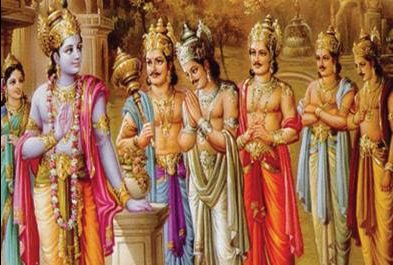The tenth chapter of the Śrīmad-Bhāgavatam, First Canto, titled “The Departure of Lord Kṛṣṇa for Dvārakā,” captures a pivotal moment in the epic narrative: Kṛṣṇa’s departure from Hastināpura to His kingdom, Dvārakā. It not only marks a geographical transition but symbolizes deeper lessons about devotion, duty, and detachment. This chapter is rich with lessons, emotions, and spiritual truths, making it both a fascinating story and an inspiring guide for sincere seekers.
Mahārāja Yudhiṣṭhira’s Reign: The Burden of Duty and Righteous Rule
The chapter begins with Śaunaka Ṛṣi inquiring from Sūta Gosvāmī about the state of affairs after the Kurukṣetra War. He specifically wants to know how Mahārāja Yudhiṣṭhira, known as the greatest of religious men, governed his kingdom after winning the war that claimed many lives. Yudhiṣṭhira’s rule was just and grounded in dharma (righteousness). He ruled not out of desire for power or personal enjoyment but as a responsibility bestowed upon him by Kṛṣṇa.
Despite his victory, Yudhiṣṭhira could not enjoy the fruits of his success, as his heart was weighed down by the destruction caused during the war. This illustrates the Vedic principle that a truly virtuous person doesn’t find pleasure in material gain, especially when it comes at the cost of others’ suffering. It also highlights that even when duty involves difficult decisions, it should be carried out with integrity and under the guidance of spiritual wisdom.
Lesson: The burden of leadership is often heavy, but a true leader, like Yudhiṣṭhira, rules with compassion and responsibility, prioritizing the welfare of the people over personal gain. In modern times, leaders and individuals can learn to act selflessly and make decisions that align with the greater good rather than personal ambition.
Lord Kṛṣṇa’s Role as the Supreme Protector
Sūta Gosvāmī narrates how Lord Kṛṣṇa, the Supreme Personality of Godhead, was satisfied after re-establishing Yudhiṣṭhira on the throne. Kṛṣṇa ensured the restoration of the Kuru dynasty, which had suffered great losses due to internal conflicts, symbolized by the “bamboo fire” of anger. The metaphor of the “bamboo fire” reflects the nature of conflicts in the material world, where individuals’ selfish desires cause suffering to themselves and others.
The Lord, however, is beyond such conflicts and takes part in them only to uphold righteousness. Kṛṣṇa’s presence in the Battle of Kurukṣetra was meant to ensure that the rightful heir, Yudhiṣṭhira, would establish a peaceful regime based on dharma. Kṛṣṇa desires that the living beings return to their spiritual essence, which is marked by devotion, detachment, and righteousness.
Lesson: Kṛṣṇa’s intervention in worldly affairs shows that the Lord never abandons His devotees. He supports those who are aligned with dharma, ensuring their protection and success in the long run. It also emphasizes that divine intervention can manifest in various ways, including through the presence of a just ruler like Yudhiṣṭhira.
The Emotional Farewell: Devotion in Separation
After restoring the rightful rule, Kṛṣṇa decided to leave Hastināpura for Dvārakā. This departure triggered deep feelings of separation among the Pāṇḍavas, their family members, and the citizens of Hastināpura. The love and attachment the Pāṇḍavas had for Kṛṣṇa were not merely due to His role as a protector but as their intimate well-wisher and divine friend.
The royal family, led by Queen Kuntī, Draupadī, Subhadrā, and other queens, expressed their inability to bear separation from Kṛṣṇa. This intense feeling of separation is known in the Gaudiya tradition as viraha-bhakti, where separation from the Lord serves to intensify love for Him. The greater the sense of separation, the deeper the devotion, as it compels the devotee to constantly remember and meditate upon the Lord.
Kṛṣṇa’s departure is not just a physical event but a spiritual lesson. It shows that while the Lord may not always be physically present, His presence can be felt intensely in the hearts of His devotees. The pain of separation, paradoxically, becomes a means of bringing the devotee closer to the Lord.
Lesson: Viraha or separation from Kṛṣṇa teaches the soul the value of His association. For modern seekers, the lesson is clear: physical distance or absence of spiritual guidance is not a reason to lose faith but an opportunity to deepen one’s internal connection with the Lord. It is in these moments of spiritual drought that the fire of devotion can burn brighter.
The Journey to Dvārakā: A Lesson in Letting Go
As Kṛṣṇa set off for Dvārakā, the Pāṇḍavas and citizens of Hastināpura followed Him for some distance. Their love for Kṛṣṇa was so overwhelming that they could not bear the thought of Him leaving. However, Kṛṣṇa gently persuaded them to return, reminding them of their duties as rulers and caretakers of the people.
This teaches a vital lesson about letting go. While the presence of the Lord is supremely satisfying, one must also learn to let go when necessary, fulfilling one’s responsibilities in the material world. The Lord Himself demonstrates this detachment, despite being the most attractive personality, by departing from Hastināpura to resume His duties in Dvārakā.
Kṛṣṇa’s journey was marked by splendor and grandeur, with royal chariots, elephants, horses, and soldiers accompanying Him. Along the way, He received various offerings from the residents of the regions He passed, reflecting the people’s love and respect for Him. The chapter describes how Kṛṣṇa, despite His supreme position, humbly accepted these offerings with gratitude, displaying His accessible nature as the Supreme Personality of Godhead.
Lesson: The principle of detachment is at the heart of spiritual growth. Kṛṣṇa’s departure teaches that while attachment to the Lord is crucial, one should not neglect one’s duties. For a householder or professional, this means performing duties diligently, even while remaining connected to Kṛṣṇa internally.
The Incomparable Devotion of the Residents of Dvārakā
The chapter further elaborates on the intense devotion of the residents of Dvārakā, who were privileged to have constant access to Kṛṣṇa’s transcendental presence. Unlike the residents of Hastināpura, who had to experience the pain of Kṛṣṇa’s departure, the citizens of Dvārakā were blessed with His continual presence.
The queens of Dvārakā, such as Rukmiṇī, Satyabhāmā, and Jāmbavatī, epitomize the zenith of conjugal love and devotion. These queens were not ordinary women; they had achieved this rare relationship with Kṛṣṇa after lifetimes of penance, sacrifice, and unwavering faith. Their lives exemplify how even mundane roles, like that of a wife, can be transformed into profound acts of devotion when centered on Kṛṣṇa.
The text highlights the concept of svarūpa (one’s constitutional nature), emphasizing that the highest perfection is to engage in loving service to Kṛṣṇa according to one’s unique relationship with Him. The queens’ relationship with Kṛṣṇa is one of sweet conjugal love, while the Pāṇḍavas share a fraternal bond with Him. In both cases, it is the selfless devotion that is celebrated.
Lesson: Every soul has a unique relationship with Kṛṣṇa, which can be realized through sincere devotion. Whether one is a householder, a monk, or a professional, one’s everyday activities can become acts of devotion if they are done with Kṛṣṇa at the center.
The Ultimate Lesson: Bhakti as the Path to Liberation
The chapter emphasizes that Kṛṣṇa is the ultimate goal of life. Devotion to Him is not only the means to liberation but also the end in itself. Unlike other forms of liberation that focus on escaping material suffering, bhakti (devotion) is about establishing a loving relationship with Kṛṣṇa, which transcends even liberation. The citizens of Hastināpura and Dvārakā were liberated not because they performed austerities, but because they loved Kṛṣṇa wholeheartedly, in joy and in separation.
The chapter concludes by stating that Kṛṣṇa’s departure from Hastināpura was not a true separation. For His devotees, He remains ever-present in their hearts. He manifests Himself through His name, form, pastimes, and qualities. By hearing, chanting, and remembering Kṛṣṇa, devotees can maintain a vibrant connection with Him, regardless of physical distance.
Lesson: The essence of spiritual life is to keep Kṛṣṇa in one’s thoughts, words, and actions. Devotion, in its highest form, is characterized by constant remembrance of the Lord, not just during moments of prayer or worship but in every aspect of life.
Conclusion: Applying the Teachings of SB 1.10 in Modern Life
The story of Kṛṣṇa’s departure from Hastināpura is not merely a historical event but a source of inspiration for modern spiritual practitioners. It teaches us:
- Serve with humility: Like Yudhiṣṭhira, fulfill your responsibilities with sincerity, compassion, and a sense of duty. This aligns one’s actions with dharma, inviting divine grace into one’s life.
- Remain focused on Kṛṣṇa: While challenges in the material world are inevitable, maintaining focus on Kṛṣṇa and His teachings helps transcend them. This focus brings inner peace and contentment.
- Embrace detachment: Learning to let go is vital. While love for Kṛṣṇa can be intense, it should not lead to neglect of material responsibilities. The balance between devotion and duty is the hallmark of a true devotee.
- Cultivate remembrance: The chapter reminds us to cultivate a constant remembrance of Kṛṣṇa through hearing, chanting, and remembering. Engaging in these practices brings Kṛṣṇa’s presence into one’s life, even in the absence of His physical form.
In this way, the departure of Lord Kṛṣṇa for Dvārakā, as narrated in Śrīmad-Bhāgavatam 1.10, offers timeless lessons about devotion, duty, detachment, and the ultimate purpose of life: cultivating an eternal loving relationship with Kṛṣṇa. By imbibing these teachings, one can transform ordinary life into a sacred journey toward the divine.





